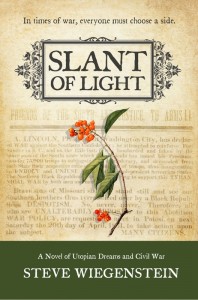 Synopsis:
Synopsis:
James Turner dreams of utopia — a community where the residents live and work together, pooling their resources and labor, and sharing equally in the benefits derived from everyone’s efforts. The son of a newspaper publisher, Turner has become a successful writer, traveling the country and lecturing about his ideas. And then, miraculously, he is offered one thousand acres of land in the Missouri Ozarks on which to found a new society and test his theories. He readily accepts, leaving his new bride, Charlotte Carr, with her military father Newton and his wife. They are grieving the loss of Charlotte’s only sister in childbirth.
It is 1857 and a young United States stands on the brink of war. Idealistic and Harvard-educated Adam Cabot has ventured into Kansas where he is attempting to run for office. But his abolitionist beliefs have placed him in grave danger and derailed his political dreams. Now he needs to flee Kansas and Charlotte longs to join Turner on his great adventure, even though he told her to wait until he is settled and sends for her. She decides to journey to Missouri and surprise Turner, so her father asks Cabot to accompany her on her journey. As they travel together, Charlotte and Cabot forge a strong friendship.
Life in Daybreak, Turner’s new community, is full of challenges, heartbreak, and lessons for the fledgling utopians. Can life in such a community really be preferable to the way of life Turner, Charlotte, and Cabot have previously known? And can the citizens of Daybreak remain neutral as the country inches closer each day toward all-out war?
Review:

Both men are changed in profound ways during their time in Daybreak. At the outset, each is idealistic and fully of lofty notions about equality and the way society ought to function. But they are also products of the unique time in which they live. Cabot is a pacifist who cannot abide violence in any form, even the slaughtering of hogs. He is mild-mannered, intellectual, and spiritual. His political ambition nearly cost him his life in Kansas, and the experience transformed him permanently. Beginning anew in Daybreak, he is at loose ends, but determined to make a difference in his own way.
There’s a certain slant of light,On winter afternoons,That oppresses, like the weightOf cathedral tunes.. . .When it comes, the landscape listens,Shadows hold their breath;When it goes, ’tis like the distanceOn the look of death.
~~ Emily Dickinson
Turner is a natural leader and as devotees of his philosophy flock to Daybreak to establish new homes for themselves, he steps up and organizes the fledgling town. Leadership is demanding and exhausting, as Turner quickly learns, especially when the leader does not have all the answers that his followers seek. Luckily for Turner, Charlotte is at his side and fully supports his dream, even though she is dismayed at the circumstances in which she finds herself living. Still, their love for each other is strong and along with Cabot and a few other trusted members of the community, they begin making progress.
But the most noble men sometimes succumb to their human desires. Turner and Cabot are not exceptions to that rule, although by the time their flaws become manifest, Wiegenstein has endeared them to readers. The same is true of Charlotte, a sturdy, determined and honorable woman who has her own opinions and ideas, and is not afraid to speak out. As each of the three main characters experience moral crises, Wiegenstein never allows them to become caricature-like or unsympathetic. Rather, their experiences and dilemmas are believable and multi-dimensional. The complications in the characters’ personal lives are juxtaposed against and further muddled by the overarching matter of their determination to remain neutral — even though all are abolitionists — while outside forces increasingly demand that they align with either the Confederacy or the Union. At a critical juncture in the storyline, Cabot ponders what he and his fellow pioneers set out to accomplish: “He had endured all the battles and humiliations of Kansas, he had traveled to Daybreak, all in the hope that there was a better way for mankind than strife and subjugation. He had wanted them to be a light unto nations, a sign that the human race was capable of overcoming history through intelligence and good will, . . . ” Was Daybreak worth all of the sacrifices and challenges he and the others endured?
The result is an entertaining and quite compelling story of a community beset by challenges from within, as well as outside itself. The main characters are complemented by a whole host of supporting players, each intriguing in his/her own way. Slant of Light demonstrates that even though societies may be structured differently, they all face universal challenges because of the fact that they are populated by innately imperfect people. Human emotions, desires, power struggles, and foibles impact communities in surprisingly similar ways, no matter what other factors come into play. Slant of Light would make an excellent book club selection, providing myriad angles for discussion and debate. Historical fiction lovers, particularly those enamored with Civil War-era stories, will find the tale of Turner’s great social experiment absorbing.



10 Comments
My favorite is Gone With the Wind. I read this when I was eleven and it was my first romance novel. I love stories about the Civil War and I learned a lot about it reading this book. Of course, I also loved Rhett and Scarlett and the story!
Gone With the Wind is my favorite because the characters really came alive to me.
I like Pride and Prejudice the writing and characters are great for the time.
Sarah’s Key … WWII fiction.
I like Pride and Prejudice because of the way the characters were written.
Tough question! I like quite a few. I just finished reading El Rey which is my favorite right now. It is set in Spain and Portugal and it seems as though there is not a lot of books about this countries nobles around. (at least not in english lol)
Gone With the Wind. The characters are unforgettable. Historical fiction is my fav!
I loved Elizabeth I by Margaret George because it was so readable and I learned alot about her and that time period. The author really made Queen Elizabeth I come to life through her words!
I’m stopping by from Cym’s party. This sounds like a good book, and in a similar style as other books I’ve been reading lately. Thanks for sharing your review!
I really haven’t read too much hist-fic, but I think my fav is probably Madame Tussaud. I think Michelle Moran does a great job of taking me back to an era and allowing me to really experience it.